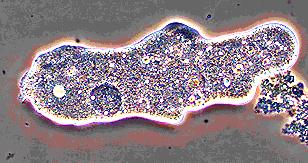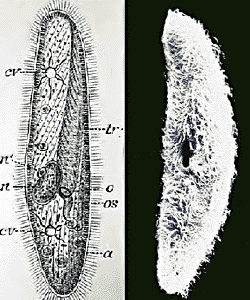Animal-Like Protists
Animal-Like Protists
Reminder: Clicking on the picture will take you to the site where I originally found it.
 This group was originally called "protozoa," meaning early or predecessor animals. Often people make the mistake of calling all protists protozoa. Oh well. Anyway, the protozoa are one celled organisms, usually living independently, often capable of movement and rely on other organisms to provide food for them.
This group was originally called "protozoa," meaning early or predecessor animals. Often people make the mistake of calling all protists protozoa. Oh well. Anyway, the protozoa are one celled organisms, usually living independently, often capable of movement and rely on other organisms to provide food for them.
The easiest way to find yourself in the company of protozoans is to go to a pond. Stagnant pond water is swarming with protists. Grab yourself a handy microscope and open your eyes to the wonders of the very small.
The most familiar of the protozoans is the amoeba. An amoeba (or ameba, for the Latin-o-phobes) is basically a living bag of water. It sloshes along in search of something to consume. When it finds something, it engulfs it. When it has sloshed around long enough and engulfed enough stuff, it divides and makes another sloshy cell.
The large round bumps on an amoeba are called pseudopoda. That's a fancy Latin way of saying "false feet." The amoeba controls its motion by pouring more of its cytoplasm in one direction. The pseudopods form as a result.
 Another familiar protist is the paramecium. A paramecium is a cell covered with small, hair-like threads called cilia. These guys are a lot like the amoeba except they tend to keep their shape and they don't slosh. They wave their cilia to move their bodies. By the way, I used to have a pet paramecium, so to speak. It was a stuffed animal I made myself. Lots of kids have teddy-bears, but all too few have combable protists.
Another familiar protist is the paramecium. A paramecium is a cell covered with small, hair-like threads called cilia. These guys are a lot like the amoeba except they tend to keep their shape and they don't slosh. They wave their cilia to move their bodies. By the way, I used to have a pet paramecium, so to speak. It was a stuffed animal I made myself. Lots of kids have teddy-bears, but all too few have combable protists.
Not all protozoans live free and easy like the paramecium. Some amoebas and other protozoans are parasites. They have adapted to life within other living creatures. This is why you shouldn't drink pond water, or any water which may have been infected. Lots of nasty little crawlies could make you sick. Some could make you die.
 Speaking of parasites, keep an eye on the protozoan which causes malaria. Certain mosquitos carry this parasite and if one of these bites a person, they can inject protists into the bloodstream. There, they multiply and can make a person terribly sick or even die. This is a huge problem in much of the world. Millions of people die from malaria every year.
Speaking of parasites, keep an eye on the protozoan which causes malaria. Certain mosquitos carry this parasite and if one of these bites a person, they can inject protists into the bloodstream. There, they multiply and can make a person terribly sick or even die. This is a huge problem in much of the world. Millions of people die from malaria every year.
Malaria.org
WHO.int
Return to the protists page,
the plant-like protists,
the fungi-like protists, or
return to the overview.
 This group was originally called "protozoa," meaning early or predecessor animals. Often people make the mistake of calling all protists protozoa. Oh well. Anyway, the protozoa are one celled organisms, usually living independently, often capable of movement and rely on other organisms to provide food for them.
This group was originally called "protozoa," meaning early or predecessor animals. Often people make the mistake of calling all protists protozoa. Oh well. Anyway, the protozoa are one celled organisms, usually living independently, often capable of movement and rely on other organisms to provide food for them. Another familiar protist is the paramecium. A paramecium is a cell covered with small, hair-like threads called cilia. These guys are a lot like the amoeba except they tend to keep their shape and they don't slosh. They wave their cilia to move their bodies. By the way, I used to have a pet paramecium, so to speak. It was a stuffed animal I made myself. Lots of kids have teddy-bears, but all too few have combable protists.
Another familiar protist is the paramecium. A paramecium is a cell covered with small, hair-like threads called cilia. These guys are a lot like the amoeba except they tend to keep their shape and they don't slosh. They wave their cilia to move their bodies. By the way, I used to have a pet paramecium, so to speak. It was a stuffed animal I made myself. Lots of kids have teddy-bears, but all too few have combable protists.  Speaking of parasites, keep an eye on the protozoan which causes malaria. Certain mosquitos carry this parasite and if one of these bites a person, they can inject protists into the bloodstream. There, they multiply and can make a person terribly sick or even die. This is a huge problem in much of the world. Millions of people die from malaria every year.
Speaking of parasites, keep an eye on the protozoan which causes malaria. Certain mosquitos carry this parasite and if one of these bites a person, they can inject protists into the bloodstream. There, they multiply and can make a person terribly sick or even die. This is a huge problem in much of the world. Millions of people die from malaria every year.